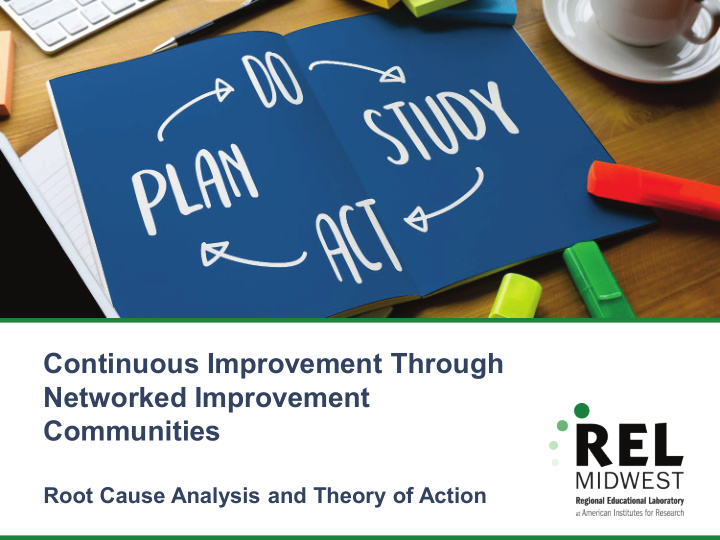



Continuous Improvement Through Networked Improvement Communities Root Cause Analysis and Theory of Action
Agenda 1. Welcome and Introductions 2. Continuous Improvement Overview 3. Root Cause Analysis 4. Theory of Action 5. Closing Remarks and Next Steps
Welcome and Introductions
Regional Educational Laboratories
Who does REL Midwest work with? School districts, state education agencies, and other educational organizations in Illinois, Indiana, Iowa, Michigan, Minnesota, Ohio, and Wisconsin
What does REL Midwest do? Applied research, technical assistance, and engagement activities to help partners understand research and evidence.
Why does REL Midwest do this work? To solve practical problems and advance fundamental understandings of education challenges and processes.
How does REL Midwest do this work? REL Midwest conducts its work through collaborative research partnerships with stakeholders in Illinois, Indiana, Iowa, Michigan, Minnesota, Ohio, and Wisconsin. To address the priorities and interests of these states, REL Midwest supports four research alliances and a networked improvement community, as well as emergent partnerships.
Types of support REL Midwest offers
Partnerships 4 Research Alliances 1 Networked • Midwest Alliance to Improvement Improve Teacher Community Preparation • Iowa Learning • Midwest Achievement Gap Research Alliance and Technology • Midwest Career Readiness Networked Research Alliance Improvement • Midwest Early Childhood Community Education Research Alliance
Continuous Improvement Overview
What is a networked improvement community?
Networked Improvement Community A networked improvement community is a collaborative research partnership that uses the principles of improvement science within a group of organizations to learn from promising practices developed in each context and how they may be adapted to other contexts.
The Improvement Process
Why use a networked improvement community?
“Rather than asking whether an ‘intervention works,’ a network improvement community asks, ‘What works, when, for whom and under what sets of circumstances?’” —Bryk, Gomez, Grunow, & LeMahieu, 2015
What does a networked improvement community do?
The PDSA cycle consists of four stages: NICs solve 1. Identify specific areas of need (Plan). problems together 2. Intervene to improve through PDSA supports to address those cycles. needs (Do). 3. Measure any changes that occur (Study). 4. Refine the intervention (Act).
Root Cause Analysis
Goals Identify specific and actionable problems. Determine the root causes of those problems. Come to consensus on which problem to address together.
Create a Focused Problem Statement Activity 1
Brainstorm problems you have experienced This week related to integration of This month technology into instructional This year practice and student learning.
Share and Group Problems
Write Problem Statement
Build Consensus
Take a Break See you in 15 minutes.
Unpack Root Causes Activity 2
Present Root Causes
Review Root Cause Analysis
Fishbone Diagram [Add fishbone diagram from Activity 2 here]
Theory of Action Activity 3
Logic Model “Logic models present a theory of action or change that drives the program or policy and makes explicit any assumptions about both the resources at the disposal of the program and the rationale behind the effort.” (Shakman & Rodriguez, 2015)
Logic Model Brings detail to broad goals Helps identify gaps in program logic and clarify assumptions Builds understanding and promotes consensus Makes underlying beliefs explicit Helps clarify what is appropriate to evaluate and when Summarizes complex programs for effective communication (Shakman & Rodriguez, 2015)
Types of Logic Models Theory approach Activities approach Outcomes approach
REL Midwest Logic Model
Example What is the input? What is the output? What is the outcome?
Theory of Action Template
Focus on Outcomes Who is the What is the In what By when? target? desired change (outcome)? (action verb)? e.g., Teachers e.g., Increase e.g., Formative e.g., March 2016 data use skills
Relate Activities to Outputs Develop a series of short, actionable If/Then statements that begin to connect activities to outputs. IF ______________ THEN ____________
Focus on Inputs What resources are readily available? What additional resources or supports are needed? Is access to these resources or inputs realistic?
Review Theory of Action Does the theory of action: Address the intended outcomes? Include activities that are feasible for the NIC to implement? Includes program outputs and outcomes that are measurable?
Take a Break See you in 15 minutes.
Measurable Aim Statement Activity 4
Aim Statement An aim statement is a written and measurable description of the desired improvement.
Aim Statement The aim statements should include: • A preset target population • A metric of interest • A change in a numerical value on the metric of interest • A timeline on which the change should occur
Next Steps
Reflections
For the next session, think about the following questions: What metrics do you already collect that can be used to track inputs, outputs, and outcomes in the theory of action? What metrics would you like to use to collect and track inputs, outputs, and outcomes in the theory of action?
IES Resources
Networked Improvement Communities
Logic Models
Bryk, A. S., Gomez, L. M., Grunow, A., & LeMahieu, P. G. (2015). Learning to improve: How America’s schools can get better at getting better . Cambridge, MA: Harvard Education Press. Shakman, K., & Rodriguez, S. M. (2015). Logic models for program design, implementation, and evaluation: Workshop toolkit (REL 2015–057). Washington, DC: U.S. Department of Education, Institute of Education Sciences, National Center for Education Evaluation and Regional Assistance, Regional Educational Laboratory Northeast & Islands. Retrieved from https://ies.ed.gov/ncee/edlabs/regions/northeast/pdf/REL_2015057.pdf
Recommend
More recommend